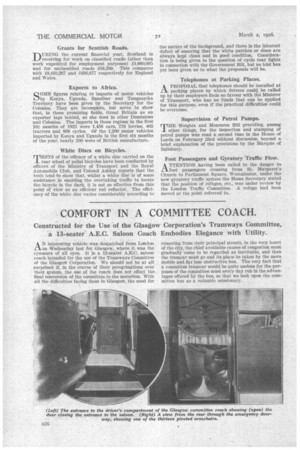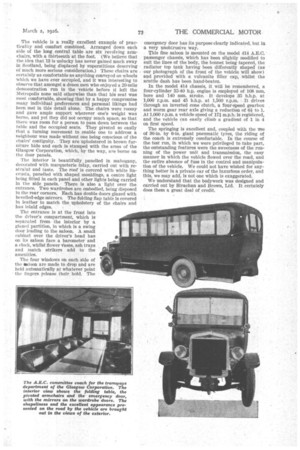COMFORT IN A COMMITTEE COACH.
Page 10

Page 11

If you've noticed an error in this article please click here to report it so we can fix it.
Constructed for the Use of the Glasgow Corporation's Tramways Committee, a 13-seater A.E.C. Saloon Coach Embodies Elegance with Utility.
_Cl A N interesting vehicle was despatched from London on Wednesday last for Glasgow, where it was the cynosure of all eyes. It is a I3-seater A.E.C. saloon coach intended for the use of the Tramways Committee of the Glasgow Corporation. We should not be at all surprised if, in the course of their peregrinations over their system, the use of the coach does not effect the final conversion of the committee to the motorbus. With all the difficulties facing them in Glasgow, the need for
removing from their principal streets, in the very heart of the city, the chief avoidable causes of congestion must gradually come to be regarded as inevitable, and then the tramcar must go and its place be taken by the more mobile and far less obstructive bus. The very fact that a committee tramcar would be quite useless for the purposes of the committee must every day rub in the advantages offered by the bus, so that we look upon the committee bus as a valuable missionary.
The vehicle is a really excellent example of practicality and comfort combined. Arranged down each side of the long central table are six revolving armchairs, with a thirteenth at the foot. (We believe that the idea that 13 is unlucky has never gained much sway in Scotland, being displaced by superstitions deserving of much more serious consideration.) These chairs are certainly as comfortable as anything conveyed on wheels which we have ever occupied, and it was interesting to observe that amongst a dozen men who enjoyed a 20-mile demonstration run in the vehicle before it left the Metropolis none said otherwise than that his seat was most comfortable, showing that by a happy compromise many individual preferences and personal likings had been met in this detail alone. The chairs were roomy and gave ample support wherever one's weight was borne, and yet they did not occupy much space, so that there was room for a person to pass down between the table and the occupied seats. They pivoted so easily that a turning movement to enable one to address a neighbour was made without one being conscious of the chairs' contiguity. They are upholstered in brown furniture hide and each is stamped with the arms of the Glasgow Corporation, which, by the way, are borne on the door panels.
The interior is beautifully panelled in mahogany, decorated with marqueterie inlay, carried out with restraint and taste. The roof is covered with white 1h2crust a, panelled with shaped mouldings, a centre light being fitted in each panel and other lights being carried in the side panels. There is also a• light over the entrance. Two wardrobes are embodied, being disposed in the rear corners. Each has double doors glazed with bevelled-edge mirrors. The folding flap table is covered in leather to match the upholstery of the chairs and has inlaid edges.
The entrance is at the front into the driver's compartment, which is separated from the interior by a glazed partition, in which is a swing door leading to the saloon. A small cabinet over the driver's head has on its saloon face a barometer and a Clock, whilst flower Vases, ash trays and match strikers add to the amenities.
The four windows on each side of the saloon are made to drop and are held automatically at whatever point the fingers release their hold, The emergency door has its purpose clearly indicated, but in a very unobtrusive way.
This fine saloon is mounted on the model 414 A.E.C. passenger chassis, which has been slightly modified to suit the lines of the body, the bonnet being tapered, the radiator top tank having been differently shaped (as our photograph of the front of the vehicle will show) and provided with a vulcanite filler cap, whilst the sOuttle dash has been hand-beaten.
In the model 414 chassis, it will be remembered, a four-cylinder 35-40 h.p. engine is employed of 108 mm. bore and 140 man. stroke, It develops 35 b.h.p. at 1,000 r.p.m. and 45 b.h.p. at 1,500 r.p.m. It drives through an inverted cone clutch, a four-speed gearbox and worm gear rear axle giving a reduction of 6i to 1. At 1,000 r.p.m. a vehicle speed of 17i m.p.h. is registered, and the vehicle can easily climb a gradient of 1 in 4 on first speed.
The springing is excellent and, coupled with the use of 36-in. by 6-in, giant pneumatic tyres, the riding of the coach is extremely comfortable. fn the course of the test run, in which we were privileged to take part, the outstanding features were the sweetness of the running of the power unit and transmission, the easy manner in which the vehicle flowed over the road, and the entire absence of fuss in the control and manipulation of the vehicle. We could not have wished for anything better in a private car of the luxurious order, and this, we may add, is not one which is exaggerated.
We understand that the bodywork was designed and carried out by Strachan and Brown, Ltd. It certainly does them a great deal of credit.




























